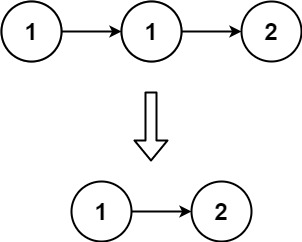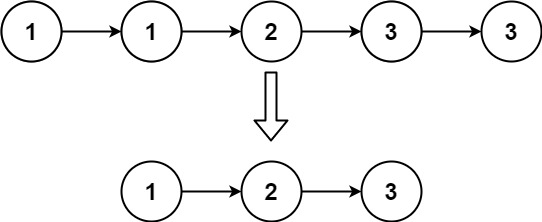C++
Java
Python
Python3
C
C#
JavaScript
Ruby
Swift
Go
Scala
Kotlin
Rust
PHP
TypeScript
Racket
Erlang
Elixir
Dart
monokai
ambiance
chaos
chrome
cloud9_day
cloud9_night
cloud9_night_low_color
clouds
clouds_midnight
cobalt
crimson_editor
dawn
dracula
dreamweaver
eclipse
github
github_dark
gob
gruvbox
gruvbox_dark_hard
gruvbox_light_hard
idle_fingers
iplastic
katzenmilch
kr_theme
kuroir
merbivore
merbivore_soft
mono_industrial
nord_dark
one_dark
pastel_on_dark
solarized_dark
solarized_light
sqlserver
terminal
textmate
tomorrow
tomorrow_night
tomorrow_night_blue
tomorrow_night_bright
tomorrow_night_eighties
twilight
vibrant_ink
xcode
上次编辑到这里,代码来自缓存 点击恢复默认模板
/**
* Definition for singly-linked list.
* struct ListNode {
* int val;
* ListNode *next;
* ListNode() : val(0), next(nullptr) {}
* ListNode(int x) : val(x), next(nullptr) {}
* ListNode(int x, ListNode *next) : val(x), next(next) {}
* };
*/
class Solution {
public:
ListNode* deleteDuplicates(ListNode* head) {
}
};
运行代码
提交
javascript 解法, 执行用时: 64 ms, 内存消耗: 50.2 MB, 提交时间: 2024-01-14 12:19:55
/**
* Definition for singly-linked list.
* function ListNode(val, next) {
* this.val = (val===undefined ? 0 : val)
* this.next = (next===undefined ? null : next)
* }
*/
/**
* @param {ListNode} head
* @return {ListNode}
*/
var deleteDuplicates = function(head) {
if (!head) return head;
let cur = head;
while (cur.next) {
if (cur.val === cur.next.val) {
cur.next = cur.next.next;
} else {
cur = cur.next;
}
}
return head;
};
java 解法, 执行用时: 0 ms, 内存消耗: 43.1 MB, 提交时间: 2024-01-14 12:19:31
/**
* Definition for singly-linked list.
* public class ListNode {
* int val;
* ListNode next;
* ListNode() {}
* ListNode(int val) { this.val = val; }
* ListNode(int val, ListNode next) { this.val = val; this.next = next; }
* }
*/
class Solution {
public ListNode deleteDuplicates(ListNode head) {
if (head == null) return head;
ListNode cur = head;
while (cur.next != null) {
if (cur.val == cur.next.val) {
cur.next = cur.next.next;
} else {
cur = cur.next;
}
}
return head;
}
}
cpp 解法, 执行用时: 8 ms, 内存消耗: 11.8 MB, 提交时间: 2024-01-14 12:18:58
/**
* Definition for singly-linked list.
* struct ListNode {
* int val;
* ListNode *next;
* ListNode() : val(0), next(nullptr) {}
* ListNode(int x) : val(x), next(nullptr) {}
* ListNode(int x, ListNode *next) : val(x), next(next) {}
* };
*/
class Solution {
public:
ListNode* deleteDuplicates(ListNode* head) {
if (!head) return head;
ListNode* cur = head;
while (cur->next) {
if (cur->val == cur->next->val) {
cur->next = cur->next->next;
} else {
cur = cur->next;
}
}
return head;
}
};
golang 解法, 执行用时: 4 ms, 内存消耗: 3.1 MB, 提交时间: 2021-07-20 09:58:26
/**
* Definition for singly-linked list.
* type ListNode struct {
* Val int
* Next *ListNode
* }
*/
func deleteDuplicates(head *ListNode) *ListNode {
var current *ListNode = head
for current != nil && current.Next != nil {
if current.Val == current.Next.Val {
current.Next = current.Next.Next
} else {
current = current.Next
}
}
return head
}
golang 解法, 执行用时: 4 ms, 内存消耗: 3.6 MB, 提交时间: 2021-07-20 09:57:34
/**
* Definition for singly-linked list.
* type ListNode struct {
* Val int
* Next *ListNode
* }
*/
func deleteDuplicates(head *ListNode) *ListNode {
sentinel := &ListNode{Val:0}
sentinel.Next = head
curr, prev := head, sentinel
mp := map[int]int{}
for curr != nil {
if _, ok := mp[curr.Val]; ok {
prev.Next = curr.Next
} else {
prev = curr
mp[curr.Val] = 1
}
curr = curr.Next
}
return sentinel.Next
}
python3 解法, 执行用时: 48 ms, 内存消耗: 13.6 MB, 提交时间: 2020-11-16 18:21:53
# Definition for singly-linked list.
# class ListNode:
# def __init__(self, x):
# self.val = x
# self.next = None
class Solution:
def deleteDuplicates(self, head: ListNode) -> ListNode:
if head is None or head.next is None:
return head
head.next = self.deleteDuplicates(head.next)
if head.val == head.next.val:
head = head.next
return head

